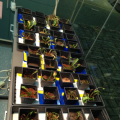Day 5 – July 7, 2014
We began our week at Prairie Ridge searching for dandelions to use in our dandelion microbiome research project. It was a challenge, but we finally found and dug up over 30 dandelions. Once back at the museum, Julia bleached the roots and Amy, Arthina and I each took turns sifting the soils we brought from home and replanted the dandelions in this soil. It will be interesting to see if the dandelions can reestablish the microbes in the new soil.
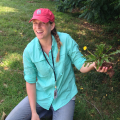
Next, our team created a display to put in the window of the Genomics Lab. The display showed the steps of our project and communicated the main research question: Will dandelions find symbiosis in our sample soils? It is cool to have a display in the museum!
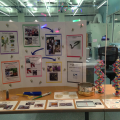
Day 6 – July 8, 2014
Today we learned more from Dr. Julie Urban about PCR (polymerase chain reaction) and how the thermal cycler uses a heating and cooling cycle to replicate the DNA. As two of us met with Dr. Urban we each took turns working with our mentor, Julia to learn the process of DNA extraction. We used the soils we collected around the museum block to practice extracting the DNA. i choose the soil found around the Rachel Carson statue as my practice soil (thinking it would give me good results – ha). Once we had all extracted the DNA from our soils, Julia showed us the NanoDrop machine that would measure the concentration and quality of our samples. I was so excited to see that my Rachel Carson sample had a high quality result and so did Amy and Arthina’s sample. To end the day we set up the PCR mixture and put it in the thermal cycler – anxious to see our first PCR results tomorrow.

Day 7 – July 9, 2014
Today we are going to run our first gel! We first learned how to create a gel for electrophoresis. We then put our DNA into the gel and ran the electricity through it which allows us to see if we ran the correct DNA strands for sequencing. Unfortunately we were not successful running our first gel – Julia thinks we may have left out the Taq – a key ingredient in the solution mixed with the DNA 🙁 We will try again tomorrow.
Julia had an innovative idea to create an agar made from our soils, so we learned how to make Soil Agar today. We ended our day having fun looking at the agar plates full of bacteria from the soils we collected from around the museum. We used the dissecting scope to view the plates and talked about how our students would also enjoy exploring this part of the project.
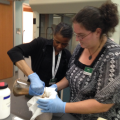
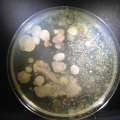
Day 8 – July 10, 2014
Today we created our PCR and ran our gels again … success!! Below is a photo of our successful gel and we joked about how proud we were – almost like a baby’s sonogram:)
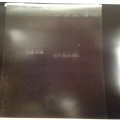
We had good time today to talk about curriculum connections. We met with Julia in the conference room and she shared two great Next Generation Sequencing Data programs: MG-RAST & STAMP. These will be very useful during the school year when we receive the data back from Juila and begin the process of analyzing the data about different bacteria and fungi found in our soil samples.
Next we enjoyed a Daily Planet talk from Dr. Julie Urban entitled Bugs in Bugs: Symbiosis. Her talk was intriguing about planthoppers that have cells in their bodies just for bacteria. The Bobtail Squid was another symbiotic example showing how they have bioluminescent bacteria in their eyes which helps to cloak them from predators.
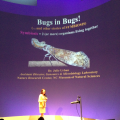
We finished our day by making three batches of agar: soil agar with bacteria, soil agar with fungi, and nutrient agar
Day 9 – July 11,2014
Today we had a Skype discussion with Dr. Meg Lowman. She is a scientist at Cal-Tech but formerly worked at the science museum and helped to write the NSF grant for the Student’s Discover Project. She was very interested to talk with each Student’s Discover team about our progress and how we see using this experience in our classroom.
The entire Student’s Discover Team met with Liz Baird to reflect on week two. Some of the topics discussed include: curriculum connections; working in teams at the museum and how to replicate the rich learning experience that we’ve received for future teachers. All the Kenan Fellows sitting around the table agreed that we have hit the jackpot of externships – the experience at the museum continues to be top notch!
Later that day we plated more of our soil samples on three different types of agar. At the end of the day, Julia asked us about extending the dandelion experiment to a month instead of a week to allow the dandelions to strongly establish themselves before we take the soil samples. I thought it was really cool that Julia was actually interested in our input about this change and we made the decision mentor with mentees. We checked on our precious dandelions one more time before we ended another fabulous week at the museum.
